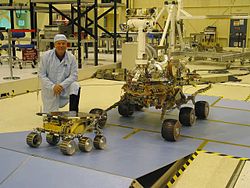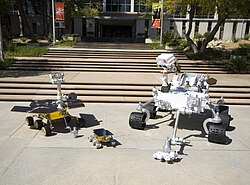Comparison of embedded computer systems on board the Mars rovers
The embedded computer systems on board the Mars rovers sent by NASA must withstand the high radiation levels and large temperature changes in space. For this reason their computational resources are limited compared to systems commonly used on Earth.[1]
In operation
Direct teleoperation of a Mars rover is impractical, since the round trip communication time between Earth and Mars ranges from 8 to 42 minutes and the Deep Space Network system is only available a few times during each Martian day (sol).[1] Therefore, a rover command team plans, then sends, a sol of operational commands to the rover at one time.[1]
A rover uses autonomy software to make decisions based on observations from its sensors.[1] Each pair of images for stereo the Sojourner rover could generate 20 navigation 3D points (with the initial software version the craft landed with). The MER rovers can generate 15,000 (nominal) to 40,000 (survey mode) 3D points.[1]
Performance comparisons
With the exception of Curiosity and Perseverance, each Mars rover has only one on-board computer. Both Curiosity and Perseverance have two identical computers for redundancy. Curiosity is, as of February 2013, operating on its redundant computer, while its primary computer is being investigated for the reasons why it started to fail.[2]
Template:Comparison embedded computer systems on board the Mars rovers
Mars Rovers
-
Size comparison of the Mars Exploration Rover (rear) and the Sojourner rover
-
Mars Science Laboratory (R); Mars Exploration Rover (L) and Sojourner rover (centre)
-
Mars Exploration Rover
See also
References
- ^ a b c d e Max Bajracharya, Mark W. Maimone, Daniel Helmick (2008) (Jet Propulsion Laboratory and California Institute of Technology); Autonomy for Mars rovers: past, present, and future; published in: Computer, a journal of the IEEE Computer Society, December 2008, Volume 41, Number 12, page 45, ISSN 0018-9162.
- ^ "Computer Swap on Curiosity Rover". NASA/JPL. February 28, 2013. Retrieved June 12, 2017.
External links






